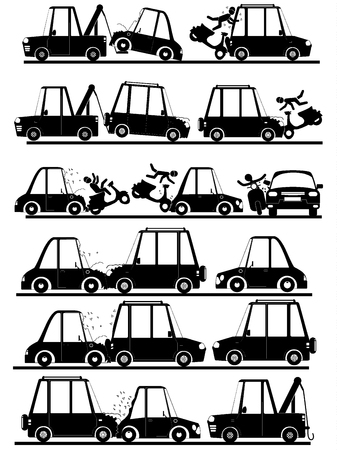Introduction to ULEZ and CAZ
The United Kingdom has taken significant strides towards tackling urban air pollution through the implementation of Ultra Low Emission Zones (ULEZ) and Clean Air Zones (CAZ). These schemes are designed to improve air quality by encouraging drivers to use vehicles that meet strict emission standards, thereby reducing harmful pollutants in densely populated areas. The primary objective of both ULEZ and CAZ is to protect public health and the environment by deterring the use of older, more polluting vehicles within targeted city centres and surrounding districts.
ULEZ was first introduced in London, where air quality issues have long been a concern due to high traffic volumes. Since its launch, other major UK cities such as Birmingham, Manchester, and Glasgow have adopted similar clean air initiatives under the CAZ framework. While there are similarities between ULEZ and CAZ, each scheme has distinct operational criteria, enforcement mechanisms, and geographical coverage. The table below provides an overview of cities currently enforcing these emission-reducing measures:
| Scheme Type | Cities Implementing | Main Purpose |
|---|---|---|
| ULEZ | London | Reduce emissions from all vehicle types in central and expanding zones |
| CAZ | Birmingham, Bath, Portsmouth, Bradford, Bristol, Sheffield, Tyneside (Newcastle & Gateshead), Manchester (pending full launch) | Targeted reduction of pollution from buses, taxis, HGVs, vans, and sometimes private cars |
Both ULEZ and CAZ operate by charging vehicles that fail to meet prescribed Euro emission standards. The charges vary depending on vehicle type and emission category, with non-compliance resulting in daily fees or penalties. These zones are crucial components in the UK’s broader strategy to achieve cleaner air and meet statutory obligations under national and European air quality directives.
2. Legal Emission Standards and Vehicle Compliance
When driving within the UK’s Ultra Low Emission Zones (ULEZ) and Clean Air Zones (CAZ), understanding the relevant legal emission standards is crucial for compliance and avoiding hefty penalties. ULEZ and CAZ schemes are designed to improve air quality by restricting access to vehicles that do not meet stringent emission requirements, primarily based on European emission standards. The most common standards affecting motorists are Euro 4 for petrol vehicles and Euro 6 for diesel vehicles. These regulations apply to a wide range of vehicle categories, including private cars, vans, minibuses, lorries, buses, coaches, and motorcycles.
What Are Euro Emission Standards?
Euro emission standards are benchmarks set by the European Union to limit exhaust emissions from new vehicles sold in Europe. Each progressive standard imposes stricter limits on pollutants such as nitrogen oxides (NOx), particulate matter (PM), carbon monoxide (CO), and hydrocarbons (HC). The implementation year for each standard varies depending on the vehicle type and fuel used.
Key Emission Standards Affecting ULEZ and CAZ Compliance
| Vehicle Type | Required Standard | Applicable Registration Date |
|---|---|---|
| Petrol Cars & Vans | Euro 4 | From January 2006 |
| Diesel Cars & Vans | Euro 6 | From September 2015 |
| Motorcycles | Euro 3 | From July 2007 |
Which Vehicles Are Affected?
The primary vehicles affected are those not meeting the minimum emission criteria outlined above. In practice, this means older petrol vehicles registered before 2006 and diesel vehicles registered before September 2015 may face daily charges if driven within designated zones. Heavy goods vehicles, buses, and coaches are also subject to separate but equally rigorous standards. Owners of classic or historic vehicles over 40 years old may be eligible for exemptions under certain circumstances.
How to Determine Your Vehicle’s Compliance
To confirm whether your vehicle meets the required standards, consult your V5C registration certificate or use official online compliance checkers provided by Transport for London (TfL) or local authorities managing CAZ areas. These tools allow you to enter your number plate and receive immediate confirmation regarding ULEZ or CAZ eligibility. It’s important to check regularly as rules are updated and additional cities introduce new clean air initiatives.

3. Payment and Charging Procedures
Understanding the payment and charging procedures for Ultra Low Emission Zones (ULEZ) and Clean Air Zones (CAZ) is crucial for all motorists driving within these regulated areas across the UK. Each zone enforces daily charges based on vehicle emissions, with strict penalties for non-compliance. Below, we break down the essential steps of the payment process, outline the daily charges, explain potential penalties, and detail methods for verifying and paying charges.
Outline of the Payment Process
The payment system is designed to be as streamlined as possible. Once you enter a ULEZ or CAZ area, Automatic Number Plate Recognition (ANPR) cameras record your vehicles registration. This data is then cross-referenced with DVLA records to determine if your vehicle meets emissions standards or if a charge applies.
Daily Charges and Payment Methods
| Zone Type | Standard Daily Charge | How to Pay |
|---|---|---|
| ULEZ (London) | £12.50 (cars/vans); £100 (lorries/buses) | Online portal, Auto Pay, phone, mobile app |
| Birmingham CAZ | £8 (cars/taxis); £50 (HGVs/buses) | Government online service, phone |
| Other Cities (e.g., Bath, Portsmouth) | Varies by vehicle/type | Government online service, phone |
Payment Deadlines
You must pay by midnight on the third day following travel to avoid penalty charges. For regular users, setting up Auto Pay can prevent missed payments and simplify compliance.
Penalties for Non-Compliance
If you fail to pay the required charge within the specified timeframe, you will receive a Penalty Charge Notice (PCN). The penalty amount varies by zone but is typically between £60 and £160, reduced by 50% if paid within 14 days. Repeat offenders may face increased scrutiny and further enforcement action.
Checking Charges and Exemptions
To check if charges apply to your vehicle or whether you qualify for exemptions (such as for residents or disabled drivers), use the official government websites or local authority portals. These platforms allow you to input your vehicle registration number and instantly view applicable charges, deadlines, and any available discounts.
Summary Table: Essential Compliance Steps
| Step | Description |
|---|---|
| 1. Check Vehicle Status | Verify if your car meets emission standards using online tools. |
| 2. Enter Zone | Your number plate is automatically registered upon entry. |
| 3. Pay Charge | Use online services or Auto Pay before deadline. |
| 4. Monitor for PCNs | If unpaid, look out for Penalty Charge Notices in post. |
This structured approach ensures drivers are well-informed about their legal responsibilities when operating vehicles within ULEZ and CAZ areas throughout the UK.
4. Exemptions and Discounts
When navigating the legal landscape of Ultra Low Emission Zones (ULEZ) and Clean Air Zones (CAZ) in the UK, it is important to understand that not all vehicles and drivers are subject to the same charges. The authorities have implemented a range of exemptions and discounts, reflecting practical concerns and a commitment to inclusivity. Below, we provide an in-depth discussion of who qualifies for these concessions, ensuring you are well-informed before entering regulated zones.
Vehicles Eligible for Exemptions
The following table summarises the main categories of vehicles that are generally exempt from ULEZ and CAZ charges:
| Vehicle Type | ULEZ | CAZ | Key Criteria |
|---|---|---|---|
| Historic Vehicles | Exempt | Varies by local authority | Registered with historic vehicle tax class; usually over 40 years old |
| Disabled Tax Class Vehicles | Exempt (until October 2027) | Often Exempt | Registered in disabled or disabled passenger tax class |
| Specialist Vehicles (e.g., agricultural machinery) | Exempt | Usually Exempt | Certain non-road going or specialist vehicles used for specific purposes |
Drivers Eligible for Discounts or Concessions
Apart from vehicle-based exemptions, certain drivers may also benefit from discounts or temporary exemptions:
- Blue Badge Holders: While Blue Badge itself does not automatically confer exemption, many local authorities offer additional support or discounted rates for disabled drivers. Verification processes typically apply.
- Taxis and Private Hire Vehicles: Licensed taxis often enjoy full or partial exemptions within their operating areas, supporting accessible public transport options.
Electric and Ultra-Low Emission Vehicles (ULEVs)
The UK’s drive towards cleaner air is evident in policies that reward electric and ultra-low emission vehicles:
- Fully Electric Vehicles (EVs): Currently fully exempt from ULEZ and most CAZ charges, incentivising uptake of zero-emissions technology.
- Plug-in Hybrids & ULEVs: May qualify for discounts depending on emissions output—drivers should consult local zone criteria.
Important Considerations for Applicants
The application process for exemptions or discounts varies by city and zone type. In most cases, vehicle registration details must be up to date with the DVLA, and supporting documentation may be required. It is advisable to check with the relevant local authority before travelling, as criteria can differ significantly between London’s ULEZ and regional CAZ schemes.
5. Penalties for Non-Compliance
Analysis of Enforcement Measures
The enforcement of Ultra Low Emission Zones (ULEZ) and Clean Air Zones (CAZ) across the UK is a critical aspect of ensuring compliance with environmental standards. Local authorities employ a combination of Automatic Number Plate Recognition (ANPR) cameras and data cross-referencing systems to identify vehicles entering regulated zones without meeting the required emission standards or failing to pay the appropriate charges. These enforcement measures are designed to maintain air quality objectives and deter non-compliance.
The Process for Issuing Penalty Charge Notices (PCNs)
When a non-compliant vehicle is detected, the registered keeper receives a Penalty Charge Notice (PCN) by post. The PCN outlines the contravention, the amount payable, and the process for payment or appeal. The table below provides an overview of typical steps following detection:
| Step | Description |
|---|---|
| 1. Detection | Vehicle identified via ANPR as non-compliant or unpaid entry |
| 2. Data Matching | Details cross-referenced with DVLA records |
| 3. PCN Issued | Notice sent to registered vehicle keeper’s address |
| 4. Payment/Appeal Window | Usually 28 days to pay at full charge or submit an appeal; reduced rate if paid promptly (typically within 14 days) |
Implications of Repeated or Serious Violations
The consequences for repeated or serious breaches are increasingly severe. Persistent offenders may face escalated penalties, including higher fines and potential legal action. Additionally, failure to pay multiple PCNs can result in debt recovery proceedings and adverse credit implications. For businesses, ongoing non-compliance may lead to reputational damage and scrutiny from regulatory bodies.
Penalty Levels Comparison
| Zone Type | Standard PCN Amount (Car) | Reduced Payment (if prompt) |
|---|---|---|
| ULEZ (London) | £180 | £90 |
| Birmingham CAZ | £120 | £60 |
Key Takeaway
Understanding and adhering to ULEZ and CAZ regulations is essential to avoid significant financial penalties and potential legal complications. Regular checks on vehicle compliance and zone charges are highly recommended for all drivers in affected areas.
6. Guidance for Visitors and Businesses
For non-residents, tourists, fleet operators, and business owners, navigating the legal requirements of driving within the UK’s Ultra Low Emission Zones (ULEZ) and Clean Air Zones (CAZ) can be complex. Understanding your obligations is essential to avoid costly penalties and ensure compliance with local regulations.
Advice for Non-Residents and Tourists
If you are visiting the UK or driving a foreign-registered vehicle into ULEZ or CAZ areas, it is crucial to check whether your vehicle meets emission standards before entering. Even if your car is registered abroad, charges may apply. Advance payment options are available online via the official Transport for London (TfL) and local authority portals. Note that penalty notices can be sent internationally, so ignorance of the rules offers no protection.
Key Steps for Overseas Drivers
| Step | Action |
|---|---|
| 1 | Check zone boundaries on official websites |
| 2 | Verify vehicle emission standards |
| 3 | Pay applicable charges before or on the day of travel |
| 4 | Retain proof of payment in case of disputes |
Guidance for Fleet Operators
Fleet managers must ensure their vehicles comply with ULEZ and CAZ requirements across different UK cities. This often involves upgrading older vehicles, implementing regular compliance checks, and registering with relevant authorities. Many zones offer discounted rates or exemptions for fleets meeting specific criteria; however, these must be applied for in advance.
Main Considerations for Fleet Compliance
- Track which vehicles enter chargeable zones daily
- Centralise compliance data to streamline reporting
- Engage with zone operators to access potential discounts or exemptions
Business Owners’ Obligations
If your business operates within a ULEZ or CAZ area—whether through deliveries, client visits, or staff commutes—it is vital to assess the cost impact and explore greener alternatives. Investing in compliant vehicles may offer long-term savings by avoiding daily charges and fines. Additionally, some local authorities provide grants or support schemes to help businesses transition to low-emission fleets.
Summary Table: Essential Actions by User Type
| User Type | Essential Action(s) |
|---|---|
| Tourist/Non-Resident Driver | Check compliance; pay charges promptly; keep documentation |
| Fleet Operator | Ensure fleet-wide compliance; register with authorities; monitor entries/exits |
| Business Owner | Assess operational impact; invest in compliant vehicles; seek grants/support where available |
Navigating ULEZ and CAZ regulations requires proactive planning and up-to-date knowledge of legal requirements. Whether you are a visitor or run a business within affected areas, staying informed will help you avoid penalties while contributing to cleaner urban air across the United Kingdom.


